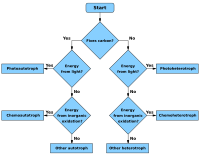Autotroph facts for kids

An autotroph is a special kind of living thing that can make its own food. The word "autotroph" comes from two Greek words: autos, meaning "self," and trophe, meaning "nutrition." So, an autotroph "feeds itself." These amazing organisms create their own energy-rich compounds from simple things like sunlight or chemicals.
Contents
Why Autotrophs Are Important
Autotrophs are super important for every food chain on Earth. Think of them as the starting point for almost all life! They grab energy from their surroundings, like sunlight or special chemicals. Then, they use this energy to build complex molecules. These molecules are like building blocks and fuel for all living things. They help cells grow and repair parts of the body.
Different Kinds of Autotrophs
There are two main types of autotrophs, depending on how they get their energy:
Photoautotrophs: Using Sunlight
Many autotrophs use sunlight to make their food. These are called photoautotrophs. The most common photoautotrophs are plants, like trees and flowers. But also, tiny algae in the ocean and some types of bacteria are photoautotrophs. They all use a process called photosynthesis. During photosynthesis, they turn sunlight, water, and carbon dioxide into food (sugars) and oxygen.
Chemoautotrophs: Using Chemicals
Some autotrophs don't need sunlight at all! These are called chemoautotrophs. Instead, they get their energy from chemical reactions. They use simple inorganic compounds, like hydrogen sulfide, iron, or ammonia. You can often find these amazing bacteria living in extreme places. This includes deep-sea vents where sunlight never reaches.
Autotrophs and Other Organisms
Organisms that cannot make their own food are called heterotrophs. They have to eat other living things to get energy. Animals, fungi, and many bacteria are heterotrophs. They either eat autotrophs (like a rabbit eating grass) or eat other heterotrophs (like a fox eating a rabbit).
There are also some interesting organisms called mixotrophs. These can switch between being an autotroph and a heterotroph. It means they can make their own food sometimes, and other times they eat other things.
Images for kids
-
Overview of cycle between autotrophs and heterotrophs. Photosynthesis is the main means by which plants, algae and many bacteria produce organic compounds and oxygen from carbon dioxide and water (green arrow).
See also
 In Spanish: Autótrofo para niños
In Spanish: Autótrofo para niños




